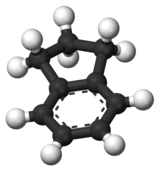This is an old revision of this page, as edited by Beetstra (talk | contribs) at 13:36, 9 August 2011 (Script assisted update of identifiers for the Chem/Drugbox validation project (updated: 'ChEBI').). The present address (URL) is a permanent link to this revision, which may differ significantly from the current revision.
Revision as of 13:36, 9 August 2011 by Beetstra (talk | contribs) (Script assisted update of identifiers for the Chem/Drugbox validation project (updated: 'ChEBI').)(diff) ← Previous revision | Latest revision (diff) | Newer revision → (diff)
| |

| |
| Names | |
|---|---|
| IUPAC name indane | |
| Other names
Benzocyclopentane Hydrindene | |
| Identifiers | |
| CAS Number | |
| 3D model (JSmol) | |
| ChEBI | |
| ChEMBL | |
| ChemSpider | |
| ECHA InfoCard | 100.007.105 |
| PubChem CID | |
| CompTox Dashboard (EPA) | |
InChI
| |
SMILES
| |
| Properties | |
| Chemical formula | C9H10 |
| Molar mass | 118.176 g/mol |
| Appearance | Clear colorless liquid |
| Boiling point | 176.5 °C (349.7 °F; 449.6 K) |
| Except where otherwise noted, data are given for materials in their standard state (at 25 °C , 100 kPa).
| |
Indane or indan is a hydrocarbon petrochemical compound.
Derivatives
Derivatives include compounds such as 1-methyl-indane and 2-methyl-indane (where one methyl group is attached to the five carbon ring), 4-methyl-indane and 5-methyl-indane (where one methyl group is attached to the benzene ring), various dimethyl-indanes, and various pharmaceutical derivatives. Other derivatives can be obtained indirectly, e.g. the reaction of diethyl phtalate with ethylacetate using metallic sodium and ethanol as a catalyst. The reaction yelds indanedione ethyl ester which can react with the sodium ions yielding a salt. This can be reversed by adding an aquous solution of hydrochloric acid.
Indane can also be converted in a catalytic reactor to other aromatics such a xylene.
Another derivative is 1,3-indandione.
See also
References
- ^ Hawley, Gessner G. (1977). The Condensed Chemical Dictionary. Van Nostrand Reinhold Company. p. 464. ISBN 0-442-23240-3.
External links
- Safety data for indane (indan) from
Physical and Theoretical Chemistry Laboratory at Oxford University.
Categories: